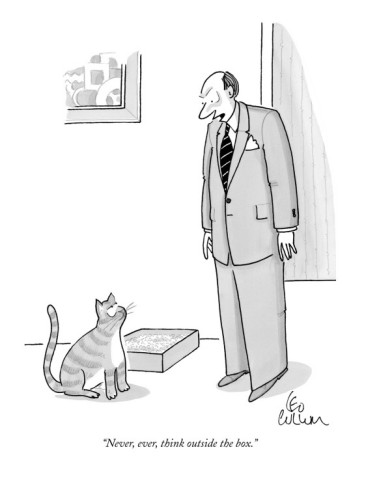13 Dec Thinking beyond the box
Overcoming barriers to exercise
 There is an excellent article by Len Kravitz, PhD in the January 2011 IDEA Fitness Journal, titled “What motivates people to exercise.” What drew my attention was a particular psychological factor in participation and adherence to exercise. “Self-efficacy is a person’s confidence in his/her ability to do exercise and be consistent with workouts.” This means that the exercise one is expected to do must seem feasible. That is, it has to be exercise an individual sees him or herself actually doing and maintaining dignity. “The more people think they can successfully do exercise, the more likely they are to adhere to an exercise program.”
There is an excellent article by Len Kravitz, PhD in the January 2011 IDEA Fitness Journal, titled “What motivates people to exercise.” What drew my attention was a particular psychological factor in participation and adherence to exercise. “Self-efficacy is a person’s confidence in his/her ability to do exercise and be consistent with workouts.” This means that the exercise one is expected to do must seem feasible. That is, it has to be exercise an individual sees him or herself actually doing and maintaining dignity. “The more people think they can successfully do exercise, the more likely they are to adhere to an exercise program.”
Many of my 3-D Workout students have told me the reason they take up 3-D Workout is because it looks like something they could do. 3-D Workout feels good, it’s restorative, it’s bio-mechanically correct, it wakes up the motoric template in the brain. Done correctly, it is safe to do even for sedentary people who want and need to get moving.
Alternatives to static stretching
Recent research with runners recommends using pre-run preparations other than static stretching to maintain endurance (Journal of Strength and Conditioning Research, 2010, 24 [9], 2274-79). I was interested to learn this and immediately thought of alternative exercises. The body integration material in 3-D Workout is great movement but it is best done indoors on a dry floor. So I began developing sequences that could be done in shoes, out-of-doors, in any weather. I hope to offer these to local runners in the near future.
New DVD
Fascial Fitness DVD: Dr. Robert Schleip and colleagues have produced a beautiful DVD called Fascial Fitness: how to train your connective tissue network (2011). These examples of fascia-friendly movements demonstrate the resiliency, elasticity, variety and sensory awareness important in fascia remodeling. Many of the sequence would be complex for beginners but an experienced teacher could modify them for best results. Go to fascialfitness.de to sample the DVD.
In The News
The American College of Sports Medicine has updated its exercise guidelines. In addition to the big three–cardio, strength and flexibility–they have added “neuromotor exercise.” (See IDEA Fitness Journal, October 2011 to read about the guidelines.) Without telling us what they mean by neuromotor exercise, the implication is that something beyond, or in addition to, the big three is needed. They do say that such exercise should provide improved gait, balance and agility. I developed 3-D Workout for just that purpose. It is my view that we need to restore the “grammar” of movement: the weight shift, level change, grounding and whole-body organizational patterns that support improved gait, balance and agility. That’s what I mean when I say “get your body together BEFORE you load it.”
Figure 8s as fascial fitness
3-D Workout is fascia-friendly. Take the Figure 8 sequence for example. By paying attention to the reach and the weightiness in the downstroke (with out-breath) of the loop and then the lightness in the upstroke (with in-breath), you will move more slowly and experience a larger use of the kinesphere. Moving in far-reach space pulls on the fascia that links your arm, shoulder and back and gives you that expanded elastic sensation that feels so good. Your weight shift will alternate between grounded and buoyant.
Fascia is coming into its own. We in the movement community are now understanding what Irmgard Bartenieff meant when she spoke of whole-body “connectedness.” Science is catching up with what we have always known intuitively: the body is fully connected and communicative within itself and beyond. It is organized by an intricate neurofascial web that surrounds every structure and enables the body to function as a whole. We now know that fascia that doesn’t move becomes matted and stuck producing the stiffness almost everyone experiences either acutely or chronically. So the adage “use it or lose it” applies not just to strength, flexibility and cardiovascular wellness but to the fitness of the fascia or connective tissue as well.
There are specific ways to restore and maintain the condition of our connective tissues. It’s in the choice and quality of movement, that is, not only ‘what’ is done but ‘how.’ For example, the movement repertoire is varied in both the use of body and space, i.e., combination sequences that use the whole kinesphere. The movement is smooth, elastic and buoyant, as well as mindful and focused. The mover pays attention to how the movement feels which means taking time, moving fully through the sequence and phrasing the movement intentionally. The mover clarifies the initiation and supports the movement with breath, space and connection to the earth. What exercise are you doing that meets these criteria?
Thanks to Tom Myers of Anatomy Trains fame for his useful article on Fascial Fitness in IDEA Fitness Journal, April 2011. The article suggests ways to re-think conventional fitness practices into movement that supports fascial wellness. And to Derrick Price of Function First, look up his article on the web, Myofascial Strength Training, April, 2012.
